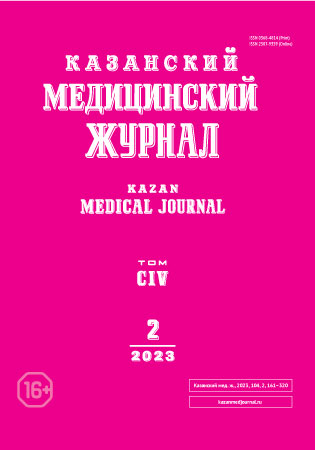Hygienic education and training — the main direction of the implementation of health-saving measures in educational organizations
- Authors: Valiev R.I.1, Radchenko O.R.1, Zhaboeva S.L.1
-
Affiliations:
- Kazan State Medical University
- Issue: Vol 104, No 2 (2023)
- Pages: 293-301
- Section: Social hygiene and healthcare management
- Submitted: 08.01.2023
- Accepted: 09.03.2023
- Published: 26.03.2023
- URL: https://kazanmedjournal.ru/kazanmedj/article/view/121298
- DOI: https://doi.org/10.17816/KMJ121298
- ID: 121298
Cite item
Abstract
Background. Hygienic education and the creation of conditions for motivating schoolchildren to health-saving behavior is the most important task of parents, teachers, the public, preventive medicine and the state.
Aim. Studying the advantages and disadvantages of educational technologies used in working with schoolchildren and their parents when conducting hygiene education in educational institutions.
Material and methods. The study consisted of four stages. At the first stage, a selective audit of information posted on 24 official websites of educational organizations in Kazan was carried out. At the second stage, 142 parents were surveyed. The third stage included work with 25 teachers in focus groups. At the fourth stage, a survey of 374 (192 girls and 182 boys) students in grades 7–10 was conducted. The results were processed using the methods of parametric and nonparametric statistics (mean value, error of the arithmetic mean, proportion of the feature, Kendal coefficient, χ2 at a significance level of α ≤0.05).
Results. Most (22 out of 24 analyzed) websites of educational organizations did not contain information on student health protection. The survey results of 142 parents showed low interest in the work carried out at the school. Evaluation of leaflets on healthy eating allowed us to choose the two most useful and informative ones: “For a teenager about nutrition. Food for the mind” (Xav=9.14 points) with consensus (W=0.744; α=0.0456) and “Healthy food for schoolchildren” (Xav=9.03 points; W=0.757; α=0.0398). The study of educational technologies used by teachers to instill in students the basic principles of health saving showed that teachers do not always use active forms. The result of a survey of 374 students was the identified need to improve knowledge in matters of self-regulation of the psychological state.
Conclusion. The study of the advantages and disadvantages of educational technologies used in the conduct of hygienic education and training of schoolchildren and their parents in the conditions of educational organizations requires further improvement and wider use of active forms of education that meet the needs of students.
Full Text
About the authors
Rushan I. Valiev
Kazan State Medical University
Email: rushan.valiev@kazangmu.ru
ORCID iD: 0000-0003-0799-1698
Senior Lecturer, Depart. of General Hygiene
Russian Federation, Kazan, RussiaOlga R. Radchenko
Kazan State Medical University
Author for correspondence.
Email: radch.olga@gmail.com
ORCID iD: 0000-0002-0616-2620
M.D., D. Sci. (Med.), Prof., Department of General Hygiene
Russian Federation, Kazan, RussiaSvetlana L. Zhaboeva
Kazan State Medical University
Email: clinic-sl@mail.ru
ORCID iD: 0000-0001-8739-9437
M.D., D. Sci. (Med.), Prof., Department of General Hygiene
Russian Federation, Kazan, RussiaReferences
- Kuchma VR, Rapoport IK, Suhareva LM, Skoblina NA, Sedova AS, Chubarovsky VV, Sokolova SB. The health of children and adolescents in school ontogenesis as a basis for improving the system of school health care and sanitary-epidemiological wellbeing of students. Health care of the Russian Federation. 2021;65(4):325–333. (In Russ.) doi: 10.47470/0044-197X-2021-65-4-325-333.
- Mamchik NP, Gabbasova NV, Kameneva OV. Hygienic education, improvement of ways and methods. Sbornik izbrannykh statey po materialam nauchnykh konferentsiy GNII “Natsrazvitie”. Sankt-Peterburg; 2021. р. 149–151. (In Russ.)
- Perekusikhin MV, Vasilyev VV, Ryabinina TV, Vasilyev EV. Sanitary and epidemiologic wellbeing and health of school children in modern conditions. Zdorove naseleniya i sreda obitaniya. 2020;(8):31–37. (In Russ.) doi: 10.35627/2219-5238/2020-329-8-31-37.
- Kornyushina TP, Shalaboda AI. On the hygiene education of schoolchildren. Metodist. 2016;(1):52–57. (In Russ.)
- Sukharev AG, Stan VV, Ignatova LF. The role of educational organizations in the development of students’ motivation to health and healthy lifestyle. Voprosy shkolnoy i universitetskoy meditsiny i zdorovya. 2016;(2):32–35. (In Russ.)
- Kuchma VR, Polenova MA, Rapoport IK, Stepanova MI, Khramtsov PI. Health-saving activities in schools of Eastern Europe and Central Asia. Zdorove naseleniya i sreda obitaniya. 2018;(8):55–58. (In Russ.) doi: 10.35627/2219-5238/2018-305-8-55-58.
- Rastorgueva TS, Shramko NV, Andreychenko SA, Moiseeva AF. Organization and methodology of hygienic education of schoolchildren. Vestnik nauchnykh konferentsiy. 2021;(8-2):87–88. (In Russ.)
- Kuchma VR, Safonkina SG, Moldovanov VV, Kuchma NYu. Hygiene of children and adolescents in modern school medicine. Gigiena i sanitariya. 2017;96(11):1024–1028. (In Russ.) doi: 10.18821/0016-9900-2017-96-11-1024-1028.
- Tapeshkina NV. Hygienic upbringing of children and adolescents: history and modernity. Zdorove naseleniya i sreda obitaniya. 2017;(3):43–46 (In Russ.) doi: 10.35627/2219-5238/2017-288-3-43-46.
- Rzyankina MF, Kostromina SA, Vasilieva ZhB. School medicine: resuts and perspectives of further scientific research. Dalnevostochnyy meditsinskiy zhurnal. 2020;(3):124–130. (In Russ.) doi: 10.35177/1994-5191-2020-3-124-129.
- Sankov SV, Kuchma VR. Hygienic assessment of the impact of the modern schools’ electronic information-educational environment on children. Vestnik novykh meditsinskikh tekhnologiy. 2019;(3):98–103. (In Russ.) doi: 10.24411/2075-4094-2019-16380.
- Makarova LP, Buynov LG, Plakhov NN. Hygienic foundations for the formation of culture of healthy lifestyle of schoolchildren. Gigiena i sanitariya. 2017;96(5):463–466. (In Russ.) doi: 10.18821/0016-9900-2017-96-5-463-466.
- Tsoy NS. Hygienic education of schoolchildren in the educational process. Materialy III Vserossiyskoy nauchno-prakticheskoy konferentsii “Aktual’nye problemy zdorov’esberezheniya i meditsinskoy profilaktiki v sovremennom pedagogicheskom protsesse”. Rostov-na-Donu; 2020. р. 128–134. (In Russ.)
- Danilenko OV, Korneva IN, Shupaev AV. Study of sanitary and hygienic training conditions in educational institutions of Orsk. Vestnik Orenburgskogo gosudarstvennogo universiteta. 2021;(2):13–17. (In Russ.) doi: 10.25198/1814-6457-230-13.
- Gladkih NP. Medico-hygienic education of pupils. Nauchnyy almanakh. 2020;(8-1):34–37. (In Russ.)
- Center for Public Health and Medical Prevention KOGBUZ “MIAC” of the Kirov Region. A teenager about nutrition. Food for brain. https://goo.su/hk1A (access date: 16.09.2022). (In Russ.)
- Chelyabinsk Regional Center for Public Health and Medical Prevention. School food. https://chocmp.ru/18763-2/ (access date: 16.09.2022). (In Russ.)
- Chelyabinsk Regional Center for Public Health and Medical Prevention. Healthy food for students. https://chocmp.ru/18767-2/#gallery-2 (access date: 16.09.2022). (In Russ.)
- Republican Center for Public Health and Medical Prevention of the Ministry of Health of the Republic of Tatarstan. Recommendations for a healthy diet. https://goo.su/eg6QYdO (access date: 16.09.2022). (In Russ.)
Supplementary files






